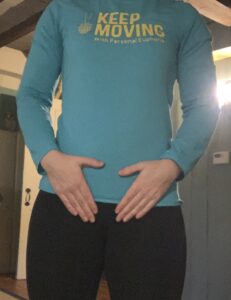One role of the pelvic floor or Kegel muscles is to aid in respiration. When we cough or sneeze and a little urine leaks out, we know that those muscles are misfiring, or maybe not firing at all. It’s super common, but not something we need to accept as normal.
But what do you do about it? Let’s start simply.
First Move: Feel the Pelvic Floor
 Lie on your back with your knees bent feet on the floor (or legs propped up on something that leaves you knees and hips at 90-degrees). Pick a position that is comfortable for you. Now just breathe and notice what you feel. When you do breathe are you aware of your pelvic floor doing anything?
Lie on your back with your knees bent feet on the floor (or legs propped up on something that leaves you knees and hips at 90-degrees). Pick a position that is comfortable for you. Now just breathe and notice what you feel. When you do breathe are you aware of your pelvic floor doing anything?
That’s it. That’s where we start. The first thing we need to consider is simply what we feel in our body. Try not to feel frustrated with yourself if you don’t feel anything or don’t know what you feel. If you can feel that the pelvic floor is getting involved you are a step ahead. If you don’t it is truly okay. Consider doing this exercise daily…with no criticism of what you feel. Just notice.
Tip: If you aren’t sure whether you are feeling your pelvic floor make sure your pelvis is neutral. See if that helps.
Also, place your hands below your belly on the front of your pelvis. Just above the crease in the front of your hips. If you can’t feel movement there with your hands, maybe you aren’t taking a deep and full enough breath to get the pelvic floor involved. Make sure you are getting your lower abs to move in and out with your breath.
Second Move: Sync ‘Em Up
Once you can feel your pelvic floor react to your breath, try to actively make it sync up with your breathing. Start in the same position. When you inhale try to let the pelvic floor lengthen. Imagine all the points in the base of your pelvis are spreading—your public bone, tail bone, and sitz bones. They all begin to pull away from each other. When you exhale do the opposite. Imagine all those points pulling closer together and envision the muscles pulling upward. This will not be a big movement. Try to get that pattern to feel like second nature.
Tip: You should still see your whole belly expanding on your inhale. This is a very deep breath. In fact you are looking to feel lots of sensation. Your belly should expand to the front, your waist to the sides, your ribs in all directions.
Third Move: Squat with Pelvic Floor Engagement
Now we’re getting bigger and trying to ensure our pelvic floor works with us when we have to do big moves or heavy lifting.
Stand with your legs hip distance apart and toes forward. Inhale to crease in the hips, sending your butt back and bending the knees to lower down (be heavy in your heels without falling over, neutral through your spine, and only go as low as feels safe in your knees). Notice your sitz bones spreading. Exhale to come up, pressing the floor away with your heels and straightening your legs. Feel your sitz bones gently squeeze together at the top.
Once you feel like you can intuitively activate the pelvic floor with these exercise, look for other moves you can consider it too—like the cat stretch. If a video format is more helpful…this will talk you through the three moves above:
Keep Reading
You can use your pelvic floor to wiggle your tail bone. Here’s how.
Want to know more about the Pilates breath and your abs? Click here.
Here’s just a great story about when my grandfather boxed during WWII.
Keep Connected
Order Your Copy of Keep Moving Today!
Subscribe to the Keep Moving Blog
Like the Personal Euphoria Facebook page
Find us on Twitter
Follow me on Instagram
Subscribe to my YouTube Channel
